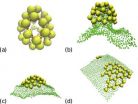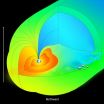(Press-News.org) A number of herbs and dietary supplements (HDS) can cause potentially harmful drug interactions, particularly among people receiving medication for problems with their central nervous or cardiovascular systems.
Those are the key findings of an extensive research review published in the November issue of IJCP, the International Journal of Clinical Practice.
Researchers examined 54 review articles and 31 original studies. They found that the greatest problems were caused by interactions between prescribed drugs and HDS that included ingredients such as St John's Wort, magnesium, calcium, iron or ginkgo.
"Consumer use of HDS has risen dramatically over the past two decades" says co-author Dr Hsiang-Wen Lin from the College of Pharmacy, China Medical School, Taiwan.
"In the USA, for example, it is estimated that more than 50 per cent of patients with chronic diseases or cancer use them and that many patients take them at the same time as prescribed medication.
"Despite their widespread use, the potential risks associated with combining HDS with other medications, which include mild-to-severe heart problems, chest pain, abdominal pain and headache, are poorly understood."
Key findings of the review included:
The literature covered 213 HDS entities and 509 prescribed medications, with 882 HDS-drug interactions described in terms of their mechanisms and severity.
Warfarin, insulin, aspirin digoxin and ticlopidine had the greatest number of reported interactions with HDS.
More than 42 per cent of the drug interactions were caused by the HDS altering the pharmacokinetics of the prescribed drugs - the process by which a drug is absorbed, distributed, metabolised and eliminated by the body.
Just over 26 per cent of the total were described as major interactions.
Among the 152 identified contraindications, the most frequent involved the gastrointestinal system (16.4%), neurological system (14.5%) and andrenal ⁄ genitourinary diseases (12.5%).
Flaxseed, echinacea and yohimbe had the largest number of documented contraindications.
"Our extensive review clearly shows that some HDS ingredients have potentially harmful drug interactions that are predominately moderate in their severity" says Dr Lin. "It also showed that herbal and botanical remedies were more likely to have documented drug interactions and contraindications than the other dietary supplements, such as vitamins, minerals and amino acids."
In an editorial on the review, Professor Edzard Ernst, Emeritus Professor, University of Exeter says that the authors provide an impressively complete overview of a fascinating and potentially important subject.
"Survey after survey shows that large proportions of the population are trying 'natural' remedies for illness-prevention, all sorts of ailments, diseases or for states of reduced well-being" he says. "Most experts therefore agree that the potential for such interactions is substantial.
"Despite this consensus and despite the considerable amount of documented harm generated by such interactions, our current knowledge is still woefully incomplete."
Professor Ernst believes that the number of interactions between HDS and prescribed drugs could be under-reported and just the tip of the iceberg.
He feels that the situation calls for rigorous research, increased awareness of possible HDS prescription interactions by physicians and patients and greater government control of this public health issue.
"Patients deserve reliable information, and it is our duty to provide it" he says. "We have to become vigilant and finally agree to monitor this sector adequately. Each individual doctor can contribute to this process by routinely including questions about alternative medicine use in their medical history taking."
### END
Herbal and dietary supplements can adversely affect prescribed drugs says extensive review
Findings could be just the tip of the iceberg says accompanying editorial
2012-10-24
ELSE PRESS RELEASES FROM THIS DATE:
Mouse model exposes a new type of T cell to target melanoma
2012-10-24
October 24, 2012, New York, NY – Cancers arise in the body all the time. Most are nipped in the bud by the immune response, not least by its T cells, which detect telltale molecular markers—or antigens—on cancer cells and destroy them before they grow into tumors. Cancer cells, for their part, evolve constantly to evade such assassination. Those that succeed become full-blown malignancies. Yet, given the right sort of help, the immune system can destroy even these entrenched tumors.
In the October 22nd issue of the Journal of Experimental Medicine, researchers led by ...
A new take on the Midas touch -- changing the color of gold
2012-10-24
Red gold, green gold – a ground-breaking initiative has found a way of changing the colour of the world's most iconic precious metal.
A University of Southampton team have discovered that by embossing tiny raised or indented patterns onto the metal's surface they can change the way it absorbs and reflects light – ensuring our eyes don't see it as 'golden' in colour at all.
The finding results from a major initiative funded by the Engineering and Physical Sciences Research Council (EPSRC) targeting the development of a new generation of nanotechnology-enabled materials. ...
The majority of roadkill amongst vertebrates in Catalonia are in protected areas
2012-10-24
Amphibians are the vertebrate group that is more likely to become roadkill in Catalonia, even more so than reptiles, mammals and birds. This is the case according to an international team of scientists who have concluded that highly protected areas are home to more cases of animal death on the roads.
Our network of roads is considered one of the main threats to fauna survival. Researchers at the universities of Barcelona (UB), Porto (Portugal) and Uppsala (Sweden) have studied the number of vertebrate deaths on 820 kilometres of road in North Eastern area of Spain and ...
New insights into membrane-assisted self-assembly
2012-10-24
"In our current paper we present new computational results that explore how membranes may influence crucial biological processes", explains Richard Matthews, Lise-Meitner-Fellow at the University of Vienna and first author of the study. The focus of the investigation is the self-assembly of microscopic particles, the formation of structures or patterns without human intervention. More specifically, the effect of the interactions between membranes and proteins, which can influence the formation of ordered structures in cells, is considered.
Self-assembly has become a hot ...
Study: Flame retardant 'Firemaster 550' is an endocrine disruptor
2012-10-24
The flame-retardant mixture known as "Firemaster 550" is an endocrine disruptor that causes extreme weight gain, early onset of puberty and cardiovascular health effects in lab animals, according to a new study spearheaded by researchers from North Carolina State University and Duke University.
Firemaster 550 is made up of four principal component chemicals and is used in polyurethane foam in a wide variety of products, ranging from mattresses to infant nursing pillows. The flame-retardant mixture was developed by Chemtura Corp., and was first identified by the research ...
Voice prostheses can help patients regain their lost voice
2012-10-24
Help is on the way for people who suffer from vocal cord dysfunction. Researchers are developing methods that will contribute to manufacturing voice prostheses with improved affective features. For example, for little girls who have lost their voices, the improved artificial voice devices can produce age-appropriate voices, instead of the usual voice of an adult male. These advances in artificial voice production have been made possible by results achieved in a research project led by Professor Samuli Siltanen, results that are good news indeed for the approximately 30,000 ...
Unearthing a hidden dietary behavior
2012-10-24
Though it was identified as a disorder as early as the 14th century, pica, or the eating of non-food items, has for years believed to be all but non-existent in a few corners of the globe – a 2006 study that reviewed research on pica found just four regions – the South of South America, Japan, Korea and Madagascar –where the behavior had never been observed.
A new Harvard study, however, is showing that pica – and particularly geophagy, or the eating of soil or clay, is far more prevalent in Madagascar, and may be more prevalent worldwide, than researchers previously ...
Hypnosis helps hot flashes
2012-10-24
CLEVELAND, Ohio (October 24, 2012)—Hypnosis can help cut hot flashes by as much as 74%, shows a study supported by the National Center for Complementary and Alternative Medicine. This is the first controlled, randomized study of the technique to manage hot flashes, which affect as much as 80% of women who go through menopause. The study was published online this month in Menopause, the journal of the North American Menopause Society.
Controlled, randomized studies may pit an active drug against an inactive placebo pill. But it's hard to find a placebo for mind-body techniques. ...
Brainwave training boosts network for cognitive control and affects mind-wandering
2012-10-24
A breakthrough study conducted in Canada has found that training of the well-known brainwave in humans, the alpha rhythm, enhances a brain network responsible for cognitive-control. The training technique, termed neurofeedback, is being considered as a promising new method for restoring brain function in mental disorders. Using several neuroimaging methods, a team of researchers at the Western University and the Lawson Health Research Institute have now uncovered that functional changes within a key brain network occur directly after a 30-minute session of noninvasive, ...
Earth's magnetosphere behaves like a sieve
2012-10-24
ESA's quartet of satellites studying Earth's magnetosphere, Cluster, has discovered that our protective magnetic bubble lets the solar wind in under a wider range of conditions than previously believed.
Earth's magnetic field is our planet's first line of defence against the bombardment of the solar wind. This stream of plasma is launched by the Sun and travels across the Solar System, carrying its own magnetic field with it.
Depending on how the solar wind's interplanetary magnetic field – IMF – is aligned with Earth's magnetic field, different phenomena can arise ...
LAST 30 PRESS RELEASES:
Norbert Holtkamp appointed director of Fermi National Accelerator Laboratory
New agentic AI platform accelerates advanced optics design
Biologists discover neurons use physical signals — not electricity — to stabilize communication
Researchers discover that a hormone can access the brain by hitchhiking
University of Oklahoma researcher awarded funding to pursue AI-powered material design
Exploring how the visual system recovers following injury
Support for parents with infants at pediatric check-ups leads to better reading and math skills in elementary school
Kids’ behavioral health is a growing share of family health costs
Day & night: Cancer disrupts the brain’s natural rhythm
COVID-19 vaccination significantly reduces risk to pregnant women and baby
The role of vaccination in maternal and perinatal outcomes associated with COVID-19 in pregnancy
Mayo Clinic smartwatch system helps parents shorten and defuse children's severe tantrums early
Behavioral health spending spikes to 40% of all children’s health expenditures, nearly doubling in a decade
Digital cognitive behavioral treatment for generalized anxiety disorder
Expenditures for pediatric behavioral health care over time and estimated family financial burden
Air conditioning in nursing homes and mortality during extreme heat
The Alps to lose a record number of glaciers in the next decade
What makes a good proton conductor?
New science reporting guide published for journalists in Bulgaria
New international study reveals major survival gaps among children with cancer
New science reporting guide published for journalists in Turkey
Scientists develop a smarter mRNA therapy that knows which cells to target
Neuroanatomy-informed brain–machine hybrid intelligence for robust acoustic target detection
Eight SwRI hydrogen projects funded by ENERGYWERX
The Lundquist Institute and its start-up company Vitalex Biosciences Announces Strategic Advancement of Second-Generation fungal Vaccine VXV-01 through Phase 1 Trials under $40 Million Competitive Con
Fine particles in pollution are associated with early signs of autoimmune disease
Review article | Towards a Global Ground-Based Earth Observatory (GGBEO): Leveraging existing systems and networks
Penn and UMich create world’s smallest programmable, autonomous robots
Cleveland researchers launch first major study to address ‘hidden performance killer’ in athletes
To connect across politics, try saying what you oppose
[Press-News.org] Herbal and dietary supplements can adversely affect prescribed drugs says extensive reviewFindings could be just the tip of the iceberg says accompanying editorial


